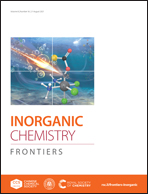On the hydrolytic stability of unsymmetric platinum(iv) anticancer prodrugs containing axial halogens†
Abstract
The longstanding notion that Pt(IV) complexes are inert under physiological conditions where there are limited reducing agents is facing a great challenge. Herein, we systematically investigated the hydrolytic stability of a wide range of unsymmetric Pt(IV) anticancer prodrugs built upon clinical Pt(II) drugs. The detailed structure–stability relationship shows that the hydrolytic stability of one certain axial ligand in Pt(IV) complexes can be dramatically affected by the other five ligands; both the coordination environment of equatorial ligands and the “trans influence” from one axial ligand affect the hydrolytic stability of the counter axial ligand, and the more electronegative axial ligand faces the higher possibility to detach. Inspiringly, this newly discovered structure–stability relationship has been successfully applied to improve the hydrolytic stability of Pt(IV) complexes that contain axial dichloroacetato ligands. Our discovery represents a significant advancement in the theory of the chemical inertness of Pt(IV) complexes toward ligand exchange reactions and provides a practical guide for the future design of Pt(IV) anticancer prodrugs.



 Please wait while we load your content...
Please wait while we load your content...